Author(s): Razvodovsky YE
Aim: The comparative analysis of the level and dynamic of the indicator of alcohol-related problems in Russia, Ukraine and Belarus.
Methods: A comparative analysis of the trends in alcohol sales (independent variable) and mortality from acute alcohol poisonings, incidence of alcohol psychoses (dependent variables) in Russia Ukraine and Belarus in the period from 1980 to 2010 was carried out. Statistical analysis (Spearman’s correlation, linear regression) was carried out using the STATISTICA 10 package.
Results: The data analysis showed that in the soviet period the level of alcohol sales correlated closely with the indirect indicators of alcohol-related problems in all countries. In the post-soviet period the level of alcohol sales statistically significant correlated with the incidence of alcoholic psychoses in Russia and mortality from acute alcohol poisonings in Belarus.
Conclusions: The findings from present study suggest that the alcohol-related problems fluctuations in Russia, Belarus and Ukraine in the soviet period were attributable to alcohol sales. Alternatively, alcohol sales cannot fully explain the fluctuations in the alcohol-related morbidity and mortality observed in these countries in the soviet period.
Alcohol is one of the main factors in the high rate of premature mortality in the Slavic republics of the former Soviet Union [1-6]. In Russia, for example, alcohol is responsible for 59% of all deaths of men and 33% of all deaths of women of working age [7]. In Ukraine, alcohol-related mortality is 40% of the total mortality of men and 22% of the mortality of women aged 20-64 [8]. The corresponding figures for Belarus are 28.4% of the total mortality of men and 16.4% of the mortality of women [9]. In the recent past, Russia, Ukraine and Belarus occupied leading positions in the world in terms of alcohol consumption [10, 11]. All of these countries have a similar pattern of alcohol consumption, characterized by the consumption of large quantities of strong alcohol in a single drink [12].
Monitoring of the alcohol-related situation in the country using indirect indicators of alcohol- related problems is an important element of a comprehensive alcohol policy [13]. The classic indicators of alcohol-related problems are the mortality rate from acute alcohol poisoning, the incidence of alcohol psychosis, and the level of alcohol sales [1]. One of the most reliable indicators is mortality from alcohol poisoning, since this indicator not only closely correlates with alcohol consumption, but also reflects the negative consequences of binge drinking pattern of alcohol consumption [5].
The incidence rate of alcoholic psychoses is an indicator alternative to the level of alcohol mortality that allows monitoring the alcohol situation in the country [8]. In the former Soviet Union, the statistical reporting of the narcological service was conducted according to a single model, which made it possible to compare the level of alcohol problems between different administrativeterritorial entities [1].
The Russian Federation, Ukraine and Belarus were in approximately the same socio-economic conditions and belonged to the republics with the highest level of alcohol problems [14]. However, these general premises are in stark contrast to the differences in socio-economic models that these countries have chosen since the collapse of the Soviet Union. In a comparative perspective, in the post-Soviet period, Belarus chose the path of less radical socio-economic reforms with the preservation of the command-administrative system and a low level of privatization [15]. On the contrary, in Russia and Ukraine, radical economic reforms were carried out, accompanied by a campaign of mass privatization [15].
The purpose of this work was a comparative analysis of the level and dynamics of indirect indicators of alcohol-related problems in Russia, Ukraine and Belarus in the period from 1980 to 2010.
Materials and Methods The data on the mortality rate from acute alcohol poisoning and the incidence of alcoholic psychoses (per 100 thousand populations) are taken from the WHO database. Alcohol sales figures (liters per capita) are obtained from publications of national statistical agencies. The study of the relationship between the independent variable (the level of alcohol sales) and the dependent variable (alcohol-related morbidity and mortality) was carried out in the Soviet (from 1980 to 1991) and post-Soviet (from 1992 to 2010) periods using the analysis of pairwise Spearman correlations using the statistical package “ Statistics”
The descriptive statistics should be presented first (Table 1). On average, for the entire period under review, the highest level of alcohol sales was noted in Belarus, and the lowest in Ukraine. This pattern took place both in the Soviet and post-Soviet periods. The highest mortality rate from acute alcohol poisoning, as well as the incidence of alcoholic psychosis in the period under review, was noted in Russia, and the lowest in Ukraine. Moreover, Russia was the leader in terms of these indicators both in the Soviet and post-Soviet periods. The lowest mortality rate from acute alcohol poisoning and the incidence of alcoholic psychoses in the Soviet period was noted in Belarus.
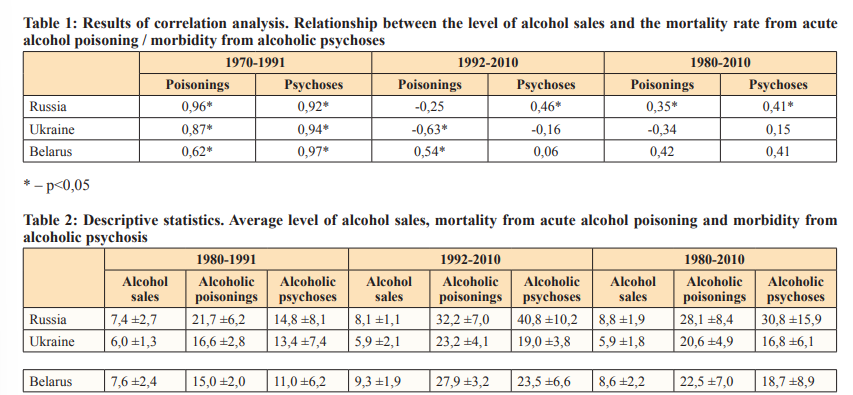
In Russia, the dynamics of three indicators of alcohol-related problems showed a similar pattern: a decline in the mid-1980s; sharp growth in the first half of the 1990s; decline in the second half of the 1990s; growth in the early 2000s followed by a decrease (Figure 1).
In Ukraine, the dynamics of indicators of alcohol-related problems was similar in the Soviet period and significantly differed in the post-Soviet period (Figure 2). In particular, in the first half of the 1990s there was a sharp increase in the mortality rate from acute alcohol poisoning against the background of a sharp decline in the level of alcohol sales.
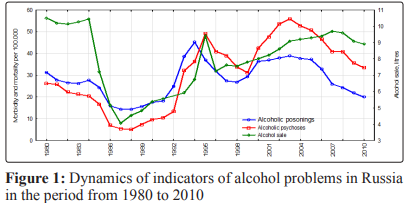
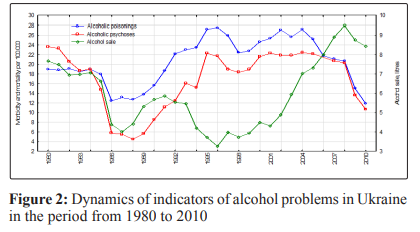
In Belarus, indicators of alcohol-related problems showed similar dynamics during the Soviet period (Figure 3). In the post-Soviet period, the general trend was an increase in the level of these indicators in the 1990s. The differences in the dynamics of these indicators lie in the fact that the peak in the incidence of alcoholic psychoses was reached in 1999, the peak in the death rate from acute alcohol poisoning in 2003, and the peak in the level of alcohol sales in 2008.
In Belarus, indicators of alcohol-related problems showed similar dynamics during the Soviet period (Figure 3). In the post-Soviet period, the general trend was an increase in the level of these indicators in the 1990s. The differences in the dynamics of these indicators lie in the fact that the peak in the incidence of alcoholic psychoses was reached in 1999, the peak in the death rate from acute alcohol poisoning in 2003, and the peak in the level of alcohol sales in 2008.
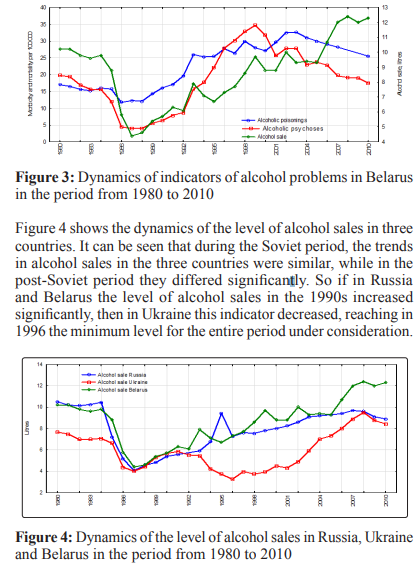
The graphical data presented in (Figure 5) indicate that during the Soviet period, the mortality rate from acute alcohol poisoning in the three countries showed a similar trend. The main difference in the trend in the mortality rate from acute alcohol poisoning in the three countries in the post-Soviet period is the sharp jump in the level of this indicator in the first half of the 1990s in Russia.
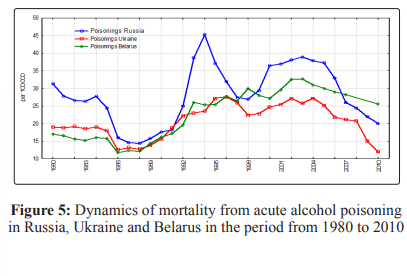
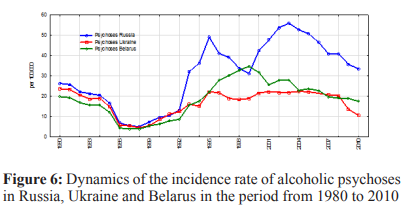
As well as the dynamics of other indirect indicators of alcoholrelated problems, the dynamics of the incidence rate of alcoholic psychoses in the three countries was similar in the Soviet period and differed significantly in the post-Soviet period. Moreover, the trend in the incidence rate of alcoholic psychoses in the postSoviet period in each country had its own characteristic pattern. The dynamics of this indicator in Russia had the character of highamplitude fluctuations with peaks in 1995 and 2003. In Belarus, the incidence of alcoholic psychosis grew linearly, reaching a peak in 1999, after which it began to decline. In Ukraine, there was an increase in the incidence of alcoholic psychoses until 1995, after which the level of this indicator stabilized.
Correlation analysis of data for the entire period under consideration revealed a positive relationship between the sale of alcohol and mortality from acute alcohol poisoning, as well as the incidence of alcoholic psychoses in Russia. In Ukraine and Belarus, there is no connection between these indicators. Analysis of data for the period from 1980 to 1991 and from 1992 to 2010 showed that during the Soviet period, the level of alcohol sales was closely correlated with indirect indicators of alcohol-related problems in all countries. In the post-Soviet period, the level of alcohol sales is statistically significantly associated with the incidence of alcohol psychosis in Russia and mortality from acute alcohol poisoning in Belarus.
During the Soviet period, the dynamics of indicators of alcoholrelated problems in the three countries had a similar pattern, which was characterized by a downward trend in the early 1980s, a sharp decline in the mid-1980s (the effect of the anti-alcohol campaign 1985-1988) with a subsequent upward trend. It should be noted that the anti-alcohol campaign practically leveled the differences in the level of alcohol-related problems in the three countries, which took place in the early 1980s. At the beginning of the period under review, the mortality rate from acute alcohol poisoning in Russia was significantly higher than that in Ukraine and Belarus, while the differences in the incidence of alcoholic psychoses were not so significant. It can be assumed that the reason for these differences is a more “detrimental” or intoxication-oriented style of alcohol consumption in Russia. In addition, we can say that the anti-alcohol campaign 1985-1988 had the most pronounced sanitizing effect in the country with the highest level of alcoholrelated problems, i.e. in Russia. One should also pay attention to the obvious paradox, which is that during the Soviet period Belarus had the lowest level of alcohol morbidity and mortality against the background of the highest level of alcohol sales. This dissonance may indirectly indicate that during the Soviet period in Belarus the level of alcohol sales did not differ significantly from the level of its real consumption, while in Russia and Ukraine unregistered alcohol occupied a significant share in the structure of alcohol consumption.
In the post-Soviet period, each country had its own characteristic pattern of dynamics of the level of alcohol-related problems. In Russia, the dynamics of the mortality rate from acute alcohol poisoning and the incidence of alcoholic psychosis were characterized by high-amplitude fluctuations with peaks in 1994/1995 and 2003. In Ukraine, these fluctuations were smoother, and in Belarus, the dynamics of the level of alcoholrelated morbidity and mortality was characterized by a linear increase with a subsequent decrease. Since the likely reason for the differences in the dynamics of the level of indicators of alcohol problems in the post-Soviet period is the differences in the state alcohol policy, it is appropriate to briefly describe the events that took place on the alcohol scene in each of the three republics.
The most significant event that influenced the alcohol-related situation in the post-Soviet period in Russia was the abolition of the state alcohol monopoly in 1992 [16]. Peak levels of alcohol morbidity and mortality in 1994/1995 associated with the flooding of the alcohol market with cheap counterfeit vodka and alcohol substitutes [1]. While the decline in the level of alcohol problems in the period from 1995 to 1998 to some extent attributed to the restoration of the state alcohol monopoly and the strengthening of the fight against illegal alcohol [2]. Strengthening state control over the alcohol market, which began with the creation of Rosspirtprom in March 2000, the leading Russian expert A.V. Nemtsov called the beginning of a new anti-alcohol campaign [17, 18].
The most important event within the framework of this campaign was the adoption in 2005 of amendments to the federal law “On state regulation of the production of ethyl alcohol, alcohol and alcohol-containing products” No. 171 of 22.11.95, in the form of two laws (102-FZ and 209-FZ), which seriously affected the alcoholic situation in the country [19]. One study showed that the introduction of new anti-alcohol laws reduced the annual number of deaths of men from alcohol poisoning by 6,700, as well as deaths from alcoholic cirrhosis of the liver among men by 760 men and among women by 770 [20]. This means that if anti-alcohol measures were not introduced, the number of deaths of men from alcohol poisoning would be 35% higher, and the number of male and female deaths from alcoholic cirrhosis of the liver would be 9% and 15% higher, respectively. At the same time, the adoption of new laws did not affect the mortality rate from mental and behavioral disorders caused by alcohol use, on the basis of which the authors concluded that the measures taken only partially explain the decrease in the level of alcohol mortality in Russia, noted after 2003 [20].
In subsequent years, the state took a number of additional measures to improve control over the alcohol market [21-25]. Some researchers believe that the decline in alcohol consumption and alcohol mortality after 2008 was partly due to the introduction of the technical regulation system of the EGAIS market [6]. According to other experts, multiple attempts to introduce this system led only to the destabilization of the alcohol market [26].
The abolition of the state alcohol monopoly in Russia in 1992 caused chaos in the alcohol market in Belarus. Due to the lack of borders with neighboring republics, the alcohol market was swept by a wave of imported vodka and spirits, which led to a sharp increase in the level of alcohol problems in the 1990s. [27]. The government responded to this growth by trying to tighten control over the alcohol market in the late 1990s. In particular, on July 20, 1998, Law No. 193-3 “On State Regulation of the Production and Turnover of Alcoholic Products” was adopted. The document determined the procedure for licensing activities for the production, wholesale and retail trade, import and export of alcohol.
Further, on August 3, 1999, the Decree of the President of the Republic of Belarus “On additional measures for state regulation of production and circulation of alcoholic, non-food alcoholcontaining products, ethyl alcohol from non-food raw materials and tobacco products was issued. The decree introduced the labeling of alcoholic beverages with excise stamps. On December 18, 2002, the Decree of the President of the Republic of Belarus “On state regulation of production, circulation and advertising of alcoholic, non-food alcohol-containing products and ethyl alcohol” was issued. The document was aimed at strengthening state control over the production and circulation of alcoholic beverages. In addition to individual legislative acts regulating the alcohol market, two state anti-alcohol programs have been consistently implemented in Belarus.
The Decree of the Council of Ministers of Belarus No. 1332 of 23 August 2000 approved the “State program of national actions to prevent and overcome drunkenness and alcoholism for 2000- 2005”. The program provided for the introduction of a ban on advertising of alcoholic products, a reduction in the production of spirits and, at the same time, an increase in the production of high-quality wines, beer, and soft drinks. In addition, the program included a wide range of measures to improve the efficiency of the republic’s narcological service, strengthen the material and technical base of healthcare organizations in order to increase the availability, quality and efficiency of drug addiction care, improve the level of training of medical specialists in the prevention, diagnosis, treatment and rehabilitation of alcohol dependence.
The next “State program of national actions to prevent and overcome drunkenness and alcoholism for 2006-2010.” was approved by the Resolution of the Council of Ministers No. 556 of April 27, 2006. Particular importance in the program was given to improving legislation on the prevention and overcoming of drunkenness and alcoholism and their consequences, toughening the responsibility for drinking and selling alcoholic beverages by minors.
The program also provided for a reduction in the production of fruit and berry wine products by an average of 10% per year. In addition, the program included a wide range of measures to improve the efficiency of the treatment of alcohol dependence. It is quite possible that government measures in the field of alcohol policy are involved in reducing the level of alcohol morbidity and mortality observed in Belarus over the last decade of the period under review.
The fundamentals of the state alcohol policy of Ukraine are determined by the law “On state regulation of production, circulation of ethyl alcohol, fruit and cognac, alcoholic beverages and tobacco products” dated December 19, 1995 (with amendments and additions), as well as Section 6 of the “Tax Code of Ukraine” dated December 2 .2010, which defines the mechanism for levying excise tax. According to national experts, there is no coherent alcohol policy in Ukraine, and certain legislative acts are aimed at replenishing the budget through indirect taxes [28]. The imperfection of the state alcohol policy and the tension in the alcohol situation in the country are aggravated by the corruption of the alcohol industry [28].
A brief overview of events on the alcoholic scene indicates that in all three countries in the 1990s the alcohol market was practically not controlled by the state. In the last decade of the period under review, the most active state intervention in the field of alcohol policy was carried out in Russia, and the weakest in Ukraine. The question arises about the reasons for the differences in the dynamics of alcohol-related morbidity and mortality during the transition period in the three countries against the background of the absence of a state alcohol policy. In this context, an interesting hypothesis is that the phase fluctuations in the level of alcoholic morbidity and mortality in Russia were launched by the antialcohol campaign in 1985-1988. [2].
According to the supporters of this hypothesis, the peak in alcohol mortality in 1994 is explained by the extinction of the cohort of alcoholics who saved their lives thanks to the anti-alcohol campaign (risk transfer hypothesis). However, this hypothesis loses its credibility against the background of the absence of similar high-amplitude fluctuations in Ukraine and Belarus.
A number of limitations of this study should be noted that could have influenced the results obtained. In particular, there are unaccounted factors that could affect the dynamics of the level of alcohol-related problems. It is believed that psychosocial distress and the state of macroeconomics were important determinants of fluctuations in the level of alcohol problems in the former Soviet republics [29]. The collapse of the Soviet Union in 1991 caused a socio-economic crisis, which had dramatic consequences for the state of the physical and mental health of the population [11]. One of the possible reasons for the differences in the dynamics of the level of alcohol-related problems in the former Soviet republics may be differences in the economic strategies they have chosen. Rapid mass privatization and a sharp rise in unemployment are considered one of the reasons for the sharp rise in mortality in Russia in the early 90s of the last century [15]. There is also reason to believe that macroeconomic stabilization has been one factor in the decline in alcohol-related problems in the former Soviet republics over the past decade [6]. An indirect confirmation of this is the general regional pattern of the dynamics of alcohol-related morbidity and mortality, which was noted in the last years of the period under review, despite the differences in the degree of state control over the alcohol market in the three countries.
A significant limitation of this study is the deterioration in the reliability of official statistic on the level of alcohol-related problems in the post-Soviet period. The abolition of the state alcohol monopoly and the emergence of a private trading network in the transition period made it much more difficult to collect data on the level of alcohol sales, which negatively affected the quality of statistical data [1]. In addition, during this period, the level of consumption of unregistered alcohol sharply increased [30]. In a comparative perspective, Ukraine has the largest share of unregistered alcohol in the structure of its consumption, and this indicator has grown sharply in the post-Soviet period [4]. According to expert estimates, unregistered alcohol accounts for about 2/3 of the total level of alcohol consumption [8].
Based on the results of the correlation analysis, we can say that in the Soviet period the level of alcohol sales was a fairly reliable indirect indicator of the level of alcohol-related problems, while in the post-Soviet period this indicator has lost its reliability. The dynamics of the level of alcohol sales in the post-Soviet period in Russia and Belarus was quite similar and showed an upward linear trend, while in Ukraine this indicator was in the first half of the 1990s dropped, reaching the “bottom” in 1996. Considering the dynamics of alcohol-related morbidity and mortality, we can say that the decline in the level of alcohol sales in Ukraine in the first half of the 1990s. due to the deterioration in the reliability of official statistics. Based on the fact that in the first half of the 1990s the level and dynamics of alcohol morbidity and mortality in Ukraine and Belarus were quite similar, it can be assumed that the real level of alcohol sales in Ukraine was comparable to that in Belarus.
Another potential problem could be the poor quality of data on mortality from acute alcohol poisoning, given the increase in deaths from unknown causes that has been observed in recent years in the former Soviet republics [5]. The reliability of the incidence of alcoholic psychosis as an indicator of alcohol problems in the post-Soviet period also appears to have declined. The deterioration of the treatment and prophylactic work of the narcological service could become one of the factors that led to a sharp increase in the incidence of alcoholic psychoses in the post-Soviet period, especially in Russia [31]. Due to the lack of funding, the narcological service was reorganized, which mainly consisted in a decrease in the number of narcological dispensaries and the number of doctors, as well as a decrease in the duration of inpatient treatment [32]. A decrease in the activity of the narcological service in identifying and registering patients at an early stage of alcohol dependence has led to an increase in the incidence of alcohol psychoses [31].
Given the fact that reliability problems have indicators of both acute (mortality from acute alcohol poisoning) and chronic (incidence of alcoholic psychoses) alcohol problems, the question arises, which of them is more reliable? The available data do not allow to give an unambiguous answer to this question, which implies a comprehensive analysis of all indicators. An illustrative example in this regard is the example of Russia, where significant differences in the mortality rate from acute alcohol poisoning in comparison with other countries, which took place at the beginning of the period under review, practically leveled out, while the small differences in the incidence of alcoholic psychoses significantly increased in end of the period under review. Moreover, in Belarus at the end of the period under review, the dynamics of indirect indicators of alcohol problems differed significantly. In general, the dissonance in the dynamics of indicators of alcohol-related problems indicates deterioration in the reliability of official statistics, which makes it difficult to monitor the alcohol situation.
Thus, the results of this study suggest that fluctuations in the level of alcohol-related morbidity and mortality in Russia, Ukraine and Belarus during the Soviet period are associated with the level of alcohol sales. At the same time, the sale of alcohol cannot explain the fluctuations in the level of alcohol problems in these countries in the post-Soviet period, which is most likely due to a decrease in the quality of statistical data. A comparative analysis of the data allows us to conclude that the level of alcohol-related problems is determined not only by state alcohol policy, but also by socio-economic conditions. The similarity of the socio-economic situation in Russia, Ukraine and Belarus during the Soviet period is associated with a similar pattern of dynamics in the level of alcohol-related problems, while differences in the dynamics of indicators of alcohol-related problems in the transition period were noted against the background of the absence of alcohol policy and different socio-economic models adapted in three countries. The relevance of measures of state control over the alcohol market increases during the period of the socio-economic crisis. Improving the quality of official statistics is an obligatory condition for adequate monitoring of the alcohol-related situation.
